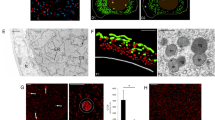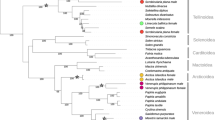Abstract
DURING the past few years, in the course of an investigation of the chemical composition of the acroblasts (‘Golgi apparatus’) in the spermatogenesis of the water-boatman (Notonecta glauca), I have been impressed by the structure of the mitochondrial Nebenkern of this animal. The male germ-cells of Notonecta are very large, the spermatozoon being more than a centimetre long, and the Nebenkern is probably the largest single body of mitochondrial origin that occurs in any organism. Its development and subsequent history were worked out long ago by Pantel and de Sinéty1, Poisson2 and Voïnov3. It is formed by the fusion of the mitochondria present in the young spermatid.
This is a preview of subscription content, access via your institution
Access options
Subscribe to this journal
Receive 51 print issues and online access
$199.00 per year
only $3.90 per issue
Buy this article
- Purchase on Springer Link
- Instant access to full article PDF
Prices may be subject to local taxes which are calculated during checkout
Similar content being viewed by others
References
Pantel, J., and de Sinéty, R., La Cellule, 23, 87 (1906).
Poisson, R., Arch. Zool. exp. gén., 66, 23 (1927).
Voïnov, D., Arch. Zool. exp. gén., 67, 1 (1927).
Sjöstrand, F. S., and Rhodin, J., Exp. Cell Res., 4, 426 (1953).
Author information
Authors and Affiliations
Rights and permissions
About this article
Cite this article
BAKER, J. Mitochondrial Nebenkern of the Water-boatman. Nature 177, 1039–1040 (1956). https://doi.org/10.1038/1771039b0
Issue Date:
DOI: https://doi.org/10.1038/1771039b0
Comments
By submitting a comment you agree to abide by our Terms and Community Guidelines. If you find something abusive or that does not comply with our terms or guidelines please flag it as inappropriate.



